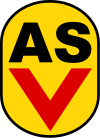Armeesportvereinigung Vorwärts
The Armeesportvereinigung Vorwärts (Army Sports Club Forward), briefly ASV Vorwärts, was the sport organisation of the German Democratic Republic's National People's Army (NVA) and its predecessor, the Barracked People's Police (Kasernierte Volkspolizei).

Together with the sport clubs and the Sportvereinigung Dynamo, the ASV was one of the most important supports of the GDR's achievement sport system. From their clubs in Potsdam, Frankfurt (Oder), Neubrandenburg, Stralsund or Rostock emerged well-known sportsmen like the boxer Henry Maske or the canoeist Birgit Fischer.
In almost every city with barracks or other army installations the ASV kept a training center. Apart from providing the training equipment, the most important task of the local sections was the promotion of youth sports.
The uniform ASV tracksuit, brown polyamide with yellow and red stripes on the arms and the oval ASV emblem on the left chest, attained very popular cult status amongst youth after the German reunification.
History
The Hauptverwaltung Ausbildung (HVA) of the Ministerium des Innern (DDR) founded its own sports association in Leipzig in 1950, the Vorwärts Leipzig. In the same year, the SV Sturmvogel of the Main Administration Sea Police was launched in Parow. As part of the expansion of the Barracked People's Police by the HVA, the SV Vorwärts HVA was renamed SV Vorwärts der KVP on July 1, 1952.[1] The SV Sturmvogel was attached to on August 1, 1953.[1]

References
- Hanns Leske: Vorwärts. Armee-Fußball im DDR-Sozialismus. Aufstieg und Fall des ASK/FC Vorwärts Leipzig/Berlin/Frankfurt, Göttingen 2009, S. 22.